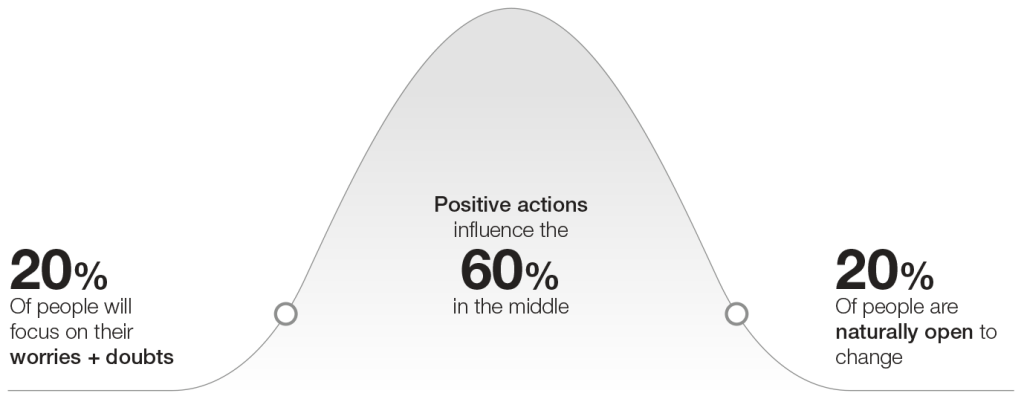Change Management: Lessons Learned + Best Practices
Planning changes to your work experience? Follow best practices instead of leaving change to chance.
For any organization seeking to improve performance, the workplace and the work experience can be particularly powerful. Of course, making changes to the workplace or the work experience should always be in service to broader business goals. Whether your organization is seeking greater growth, improved shareholder value or enhanced brand loyalty from customers, workplace and work experience are important parts of reaching those goals. They are big investments. They are highly visible and daily reminders of what your organization values.
Whatever your goal, workplace change and changes to the work experience can have a role in making it happen.
Change is a big deal—even the word itself tends to make people wary. Be judicious in how you implement change. Doing so with little support is bound to backfire, achieving plenty of resentment but little buy-in. Instead, be intentional about change management. Think of it as insurance for what’s likely to be a significant investment—an investment not only in space, but in a holistic experience and the new behaviors that will surely contribute to organizational performance.
Why it matters
Change management matters—a lot— and it’s frequently not implemented successfully. When it is, there is a significant payoff in terms of results. The Steelcase approach to change management encompasses the four elements that must work together to achieve organizational ambitions. These include culture (norms and values), process (the way work gets done), tools (technology and other work aids) and space. Focus on space alone, and you’ll be missing a big part of the picture.
Ingredients for successful change
Change always comes with a cost. Employees resist change for a variety of reasons, including perceived loss of territory and control or concerns about how they will be perceived if they aren’t prepared for new ways of doing things. They may even worry about maintaining relationships with colleagues if they’ll no longer be located near friends. Change also brings benefits—easier collaboration, greater engagement or a more energizing work environment.
Only when employees come to realize that the benefits outweigh the costs will change stand a chance. It is important to provide all of the following elements: Vision for the future of the change, knowledge of practical first steps that will be necessary in making the change and (a healthy sense of) dissatisfaction with the present. All of these must be greater than the perceived costs of the change in order for employees to be receptive to it.
But if any of these three elements are missing, employees will be hesitant to lower their guard. Without a compelling vision, change will lack direction and prompt confusion. Without knowledge of the practical steps needed to make change happen, people will distrust the process and grow frustrated. And without a healthy dissatisfaction with the way things are, people will have no reason to let go and embrace how much better they could be.
A clear vision pulls your organization forward, dissatisfaction pushes you out of your rut, and knowledge assures employees you have a firm grasp on how to bridge the gap.
Avoid the temptation to gloss over dissatisfaction with the present. It plays a big role in creating a burning need for change. Besides, employees usually understand that something is amiss. Your message: The nature of work moves faster than our workplace can keep up and we’ll embrace new ways of working and behaving in order to reach business objectives. Few would object to an effort to address that discrepancy.

An intentional, holistic approach
When approaching change management, take a holistic approach. Consider not just the communication that will need to occur, but how the change is part of your culture (and the shifts to your culture that you may be seeking). Give thought to the types of behaviors you want to foster among employees and how leaders may need to shift their approach. Plan for the overall change strategy and how it’s connected to the broader goals of the business.
In addition, be intentional about your efforts. When planning for change, follow the Goldilocks principle: Do as much as necessary, but as little as possible—in other words, whatever seems just right for your culture and situation. You don’t have to check off every conceivable change management tactic, but you must be intentional about what you do and why you’re doing it.
Be prepared to invest time and energy into the process. The alternative is simply hoping for the best, akin to having no strategy at all.
See it through
Ideally, the timeline of change management exceeds the time frame of workplace change itself—the most effective change management begins when change is first contemplated and continues even after people move into their new environment.
It starts with planning and preparing for change—articulating a vision, clarifying key messages, establishing a change management team, identifying potential challenges and barriers and developing engagement strategies.
It continues during the change—with the implementation of a detailed change management roadmap, leadership training and move-in support.
But even after people are settled in, change management must be sustained, now focused on coaching and supporting people as they adopt the change and adapt to the new experiences, and measuring results and making ongoing improvements.
Don’t be afraid to start engaging too early. Share your plan with employees before the rumor mill can start churning. Be as frank as possible as soon as possible and obtain input where it’s appropriate. If your people first learn what’s in store through a press release, their initial reaction is unlikely to be positive, meaning your change management process will start off at a disadvantage. Starting too late or stopping too soon are common errors that keep organizations from realizing the full return on their change management investment.
Be transparent
Because people can be suspicious of change, don’t be surprised if they are skeptical. Temper this reaction with transparency. Insist on candor and clarity in all communications. Coach leaders on key content and ensure overall corporate messages are aligned with the information leaders are sharing with their teams. When employees feel they’re getting the full picture about what’s happening and why, there’s less room for rumors to gain traction.
Part of being transparent is acknowledging that change involves cost. Rather than spinning the story or skirting away from this reality, confront it head on. Yes, organizational change and workplace change are big expenses. Yes, moving can be a hassle. Yes, our workplace changes will necessitate behavior changes and new ways of working. Segue from these facts into the positive trade off. The organization can become more efficient or work may become more purposeful. Maybe individual workspaces will be compressed but the campus as a whole will be enriched. Better to acknowledge the challenges than pretend they don’t exist.

Consider your context
All change is not created equal.
Before diving in, consider the context in which change is occurring in your organization. Are your people familiar with the business and workplace trends gaining favor in your industry or do you need to bring them up to speed? Have they gone through change before or will this be a new experience? Do you expect they’ll be open to change or cynical?
Following are some of the variables to clarify before crafting your change management plan.
Consider the business
Of course, the reasons for any change to the work experience are based on broader business goals. Be clear about these so you can in turn share them with key stakeholders. You may be implementing a hybrid strategy – encouraging people to work throughout the office and allowing them to work from home some days each week. Be sure you’re connecting this with the broader business reason for the change. Perhaps you’re hoping to enhance attraction and retention of talent through providing the flexibility made possible by the mobility program. Your plans for the workplace change may include fewer private offices or more areas for collabo-ration but be sure and tie this to broader goals of greater engagement, enhanced agility or faster decision making.
In order to be successful with your change management efforts, don’t just focus on the workplace or on simply communicating features or benefits of the shifts to the work experience. Be sure you’re considering the behavior changes people will need to make and clear linkages with the overall business reasons for the changes.
Consider complexity
If you’re just introducing some height adjustable workstations, you may need less in the way of true change management and more emphasis on simple communication or instruction.
But if you’re planning a fundamental transformation in how your organization works, it’s a big undertaking.
Ask yourself this: Is the change you’re proposing major, modest or middling? Implementing a full-on organizational change or moving to a different city are more challenging than shifting a department to a new floor. Introducing a mobility concept is more ambitious than adding some booths to the cafeteria. And encouraging more effective collaboration approaches is a tougher transition than simply adapting to an open plan.
Simpler projects that won’t significantly change how you do business are lower risk and require less investment in change management (think moves, adds and changes). Projects at the peak of complexity, however, are intended to transform your culture, processes, tools or space amounting to a paradigm overhaul. In these cases, the risks are as high as the potential rewards, and you can’t afford to cut corners.

Consider readiness
The particulars of your change management plan will depend a lot on your organization’s readiness. For example, are your people comfortable with change from past experience? Do you possess the necessary skills internally to manage change? Are your leaders good at modeling new behaviors? Do you already have clarity about the specific changes needed?
Be aware that readiness can differ at the organizational, team and individual levels. A clear-eyed appraisal of each provides insight into how much resistance you can expect and how to craft your change management plan accordingly.
Consider risks
The bigger the change, the greater the chance something could go wrong. By taking the time to evaluate potential risks, you can take steps to mitigate them.
Be especially vigilant against low probability risks—they often carry high consequences. After all, bringing in some digital display boards might only threaten to interrupt lunch. But if moving the IT department could trigger unexpected hiccups in manufacturing, you’ll want to formulate contingency plans.
People matter
Attending to the needs, concerns and emotions of people is key to your success in change management.
Get engaged
When managing change, you can choose from three strategies: tell, sell or engage. With tell, you say, “do it my way,” without regard for employee input. With sell, you focus on the superficial benefits of change while glossing over any potential drawbacks. Both strategies require less effort upfront and might seem like fast ways to implement change. However, these often lead to resentment, which can morph into resistance, requiring a significant time investment to overcome—time that would have been better spent early on.
With engagement, you earn the respect of employees by keeping them informed. By acknowledging that the transition will be challenging, and inviting employees’ input into the process, everyone will feel more involved. Engagement requires more effort at the beginning but produces faster buy-in, resulting in a smaller time investment as the process progresses.
Avoid surprises
Work to instill enthusiasm for change from the top down, from the bottom up and at every level between. Your goal is to eliminate surprises—so it’s vital to keep everyone in the loop every step of the way.
After all, people don’t resist change nearly as much as they resent being changed. If employees think, “you did this to us,” you’ll lose them. But if they feel, “you did this with us,” you’re on track to success.
Does that mean everyone gets a vote? Hardly. But everyone should feel they have a voice. Ensure leaders work with their teams to create a dialogue rather than simply pushing information at employees. There’s no need to delegate every decision. But try to give your people input opportunities, perhaps by inviting them to weigh in on some issues. When people feel they’re part of the process—when they have some choice and control—they tend to be more engaged.
Change management is a process that is focused on people. Get a handle on your most pressing people issues by lining up executive support and understanding the diverse mindsets of different stakeholders.
Get leaders on board
The building blocks of successful change rest on a foundation of executive support. There is little that is more important. Your most visible change champions must be senior executives. Employees want to see their commitment. If executives lack enthusiasm or display ambivalence, you’ll be hard-pressed to earn eager support from other stakeholders.
Executive sponsorship is especially critical in the beginning stages when regular communication right from the top—a weekly email or video blog— communicates how invested the organization is in making change a success. As the process progresses, executive involvement must include modeling the change—showing a willingness to try new work behaviors. Want to assure people it’s okay to work throughout the campus or specifically in the rooftop garden? Maybe your CEO should be an occasional visitor.
Change management must be intentional about engaging middle managers as well. These leaders are on the front lines, expected to soothe the concerns of their people while often being asked to undergo significant change themselves. Provide training and even consider establishing small coaching teams among leaders so they can support each other as they move through the change together.
Whether executives or middle managers, the more face-to-face communication leaders have with people, the better. In addition, leading through the change is a unique skill. Change management often includes workshops for both groups—to orient them to the process, emphasize their critical role, and share tips about overcoming resistance and gaining buy-in.

Analyze stakeholders
Many people will have a stake in your change. Their perspectives, however, will differ markedly. Some employees will go with the flow, others will dig in their heels, others won’t give the changes as much thought or attention.
It’s vital that you analyze your stakeholders. Doing so will provide clarity about whose support you can leverage, whose resistance you need to overcome and how to craft engagement strategies that will resonate with people no matter where they fall within the stakeholder analysis.
Focus on the middle
While it’s important to leverage supporters and reassure detractors, bear in mind that both groups are outliers, each representing at best 20 percent of your stakeholders. Most people—typically about 60 percent— will fall in the middle, neither fans nor foes of change, just lukewarm to what’s in store.
By far the largest employee cohort, this middle group deserves most of your focus. Frequent, targeted engagement will shift their attitudes toward the right of the bell curve— from indifferent to optimistic—giving you the biggest return on your change management efforts.
Consider the level of support you have from employees for the upcoming change. Also, give thought to how involved your employees will be and how vocal they may be about their opinions.
Let’s say your marketing people are delighted about the prospect of change and can’t stop saying so. They are demonstrating high support and high involvement. Consider pulling them in as advocates to help make your case.
Conversely, your IT people may be wary but unlikely to make waves. They may be less supportive, but also less involved—be mindful that extra reassurance might be helpful to bring them around.
Those who are not very supportive of the change and are highly involved represent a potential minefield. Stakeholders here aren’t happy and aren’t afraid to say so, potentially incubating an epidemic of negativity. Take intentional steps to provide information and support to people in these groups.
Try to convert one or two of your most visible naysayers into change cheerleaders, perhaps by including them in a pilot workspace or a new development program the organization is testing, where they can see firsthand that their fears are unfounded.
Overall, change management is a critical part of implementing a successful work experience. Your culture, process, tools and space all matter—and the process of helping people adopt and adapt to changes is an investment that will pay off in terms of both the work experience and organizational results.




